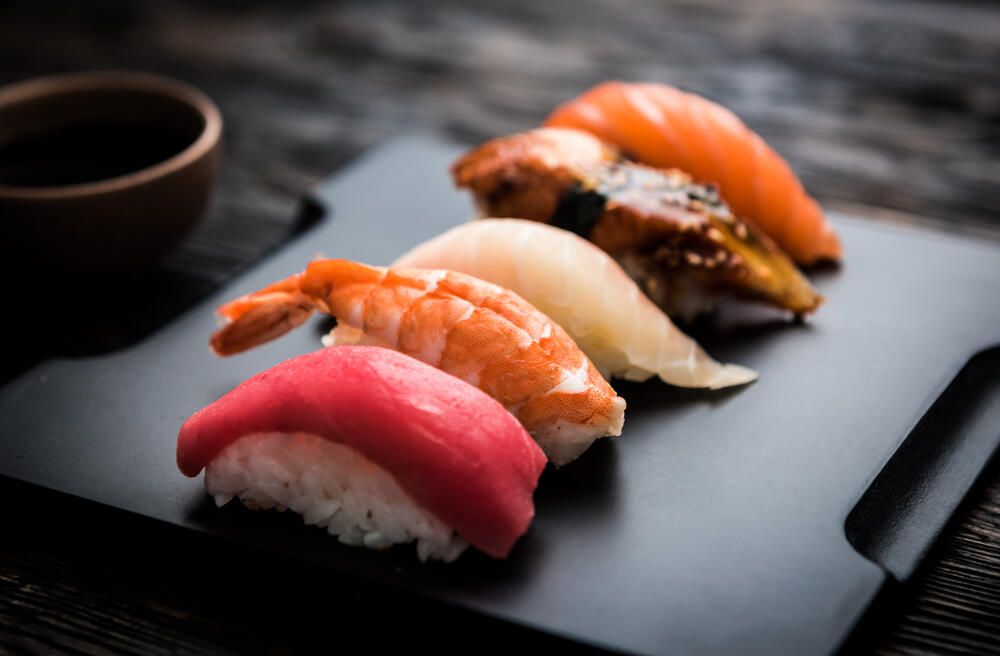When it comes to dining out during your Japan trip, you'll probably be keen to try some authentic Japanese food. In this article, we will introduce the most authentic types of fish that are often used as toppings for sushi and sashimi, two of the most well-known Japanese dishes! You can easily buy them in department store basement food sections, supermarkets, and markets in Japan, so be sure to check them out! Foreign favorites such as California rolls and fruit sushi are few and far between in Japan, so let's find out what real, authentic sushi looks like!
Jan 26. 2024
The Ultimate Guide to Authentic Sushi and Sashimi in Japan!

Tuna


The most popular sushi item in Japan is tuna (locally known as 'maguro'). At the beginning of the New Year, the first auction of tuna always makes the news.
The most common part to find in restaurants is the red meat, which is often eaten in sushi as well as sashimi. It is low in fat, has a light taste, and is low in calories and high in protein. In sushi, it is sometimes used for nigiri (pressed rice sushi), as well as for rolled sushi such as tekkamaki.
The pink “toro” is the belly part and is characterized by its sweet fat. It is graded according to the fat content, with famous grades such as "chutoro" (medium fatty tuna) and "otoro" (large fatty tuna). Otoro is taken from the belly part nearest the head. The appeal is that you can fully enjoy the sweetness and umami of the fat, and since the melting point is so low, the tuna simply melts in your mouth!
Chutoro, on the other hand, can be taken from a wide range of sections, and its name changes depending on where it is taken, such as "sekami" (back red meat), "senaka" (back middle) and "seshimo" (back closer to the tail). The amount of fat and taste also varies. Chutoro one of the most popular cuts at sushi restaurants thanks to its taste and texture profile that lies somewhere in between the lean red meat and the fatty otoro.
The red meat, otoro, and chutoro are often eaten as nigiri, sushi rolls, and temaki hand rolls. Tuna parts used for negitoro bowls and gunkanmaki rolls are called "nakaochi". This is the meat that remains around the backbone of the tuna after it has been processed, so it can be obtained cheaply at markets and supermarkets.
Memorizing these popular tuna cuts will come in useful at sushi restaurants and supermarkets!
Salmon


Salmon with its soft, pale orange color and silky fat is one of the most popular toppings at sushi restaurants. There is also a luxury cut called "Toro Salmon", but interestingly, unlike tuna, which is clearly classified and graded by part, there is no clear classification system for Toro Salmon. Instead, it is used as a blanket term to refer to salmon cuts that contain a lot of fat.
Since normal salmon cannot be eaten unless it is heated, the salmon used in sashimi and sushi is slightly different. In this case, Trout Salmon is used, which is made by farming rainbow trout in seawater. In Japanese supermarkets and fishmongers, the product name is "Trout Salmon" and it may have a bar code or label on it that confirms it can be eaten raw. Because salmon cannot be fished in Tokyo Bay, most high-end Edomae sushi restaurants historically did not offer it on the menu. However, now it has become as popular as tuna, and some Edomae sushi restaurants have started serving it, cementing salmon's place as a sushi regular.
Sea Bream


Sea bream ("tai") is considered a luxury fish in Japan, and since the Japanese word for "congratulations" ("medetai") and seabream ("tai") rhyme, it also holds meaning as lucky dish. It's delicious when boiled or cooked in dishes like sea bream rice, but if you eat it as nigiri sushi, you can further enjoy its rich flavor and delicate taste.
Mackerel


In Japan, mackerel ("saba") is often cooked over high heat, but it can also be eaten as shimesaba (cured mackerel) or mackerel sushi.
These methods were devised to preserve mackerel, which loses its freshness quickly, in the days when refrigeration technology was not yet developed. Shimesaba is a mackerel that has been sprinkled with salt and compressed, after which the salt is removed and the mackerel is soaked in vinegar. You can cut it as it is and eat it as sashimi, or you can eat it as mackerel sushi.
Oceanic Bonito


Bonito ("katsuo") is a red-fleshed fish with a light, refreshing taste. There are two fishing seasons a year - spring and autumn - with spring bonito (first bonito) being particularly popular as an auspicious ingredient that brings good luck.
It is often served as lightly seared sashimi, eaten with plenty of condiments such as green onions and myoga ginger. In addition to often being placed on the menu of restaurants and izakaya under the name of "katsuo tataki", it is also frequently used in local cuisine such as Kochi Prefecture's katsuo tataki and Mie Prefecture's hand-kneaded sushi (tegone-zushi).
Yellowtail


"Hamachi" is the Japanese name for young yellowtails (40 to 60cm in size). Although there are some differences depending on the region, yellowtails of 80cm or longer are always called "buri" in all regions. Yellowtail has a translucent, pinkish-white body and is characterized by a lot of flavorful fat. It can be eaten all year round, but winter time is when they are at their fattiest and tastiest. Both sashimi and nigiri are popular.
Greater Amberjack


Amberjack ("kanpachi") is a species of the genus Seriola of the horse mackerel family, just like yellowtail. Many are farmed, and natural ones are distributed as high-end fish. Compared to yellowtail, amberjack is characterized by less fat and less of a strong flavor. It is chewy and has a light taste, making it popular in sashimi and nigiri sushi.
Squid


Squid ("ika") is a popular seafood that can be enjoyed both as sashimi and sushi.
Squid sashimi is sometimes called "ika somen" because it is cut into thin pieces to make it easier to eat, which gives it the appearance of Japanese somen noodles. In addition, in areas such as Yobuko in Saga Prefecture where squid fishing is popular, there are areas where you can eat "live squid", which is prepared by slicing the still-living squid just before serving it!
When making sushi, linear cuts are often made in the flesh for reasons such as softening the texture and food hygeine measures. If you use squid in nori rolls or hand rolls, you can also add shiso leaves and plum paste for extra flavor.
Octopus


When octopus ("tako") is boiled in salted water, the flavor becomes more concentrated and the flesh becomes firm and crispy, making it easier to eat. High-end establishments sometimes serve octopus raw, but regular restaurants mostly use salt-boiled octopus.
Compared to raw octopus, which is characterized by its tough and crunchy texture, boiled octopus is springy yet soft and has more flavor. It is an easy dish to enjoy as sashimi or sushi.
Sweet Shrimp


Sweet shrimp ("amaebi") is one of the most popular types of shrimp served raw in Japan. Both sweet shrimp sashimi and nigiri sushi are usually served with the shell removed and the tail attached. The flavor is sweet and the texture is melt-in-the-mouth! It can be purchased as sashimi at markets and supermarkets, but it is commonly eaten as nigiri sushi or gunkanmaki.
Scallop


Fresh raw scallops ("hotate") are vastly different from their cooked counterparts. Although raw scallops have a firmer texture, the sweetness, richness, and creamy taste are exquisite!
In general, scallops are used for sashimi and sushi, but gills and mantle are also used in cooking, or served as a snack with alcohol such as Japanese sake. When eating scallops in sushi, it is common to eat them as nigiri or gunkanmaki.
Salmon Roe


Salmon roe ("ikura") is the roe of Japanese salmon, trout, and other fish, and is similar to caviar. Unlike other seafood, there is no kanji notation because the name is derived from Russian.
In Japan, salmon roe is often marinated in soy sauce and eaten as chirashi sushi or gunkanmaki. This enables diners to enjoy the texture of the salmon roe, the sweetness of the soy sauce, and the rich, gooey flavor. The translucent, bright orange eggs burst in the mouth in an incredibly unique texture, making it one of the most stand-out ingredients of gunkanmaki.
Urchin


Sea urchin ("uni") is one of the most prized and expensive delicacies in Japan. In sushi, it is one of the most popular toppings for gunkanmaki, and is characterized by its deep yellow or orange color, rich sweetness and buttery taste.
To preserve the color and freshness of sea urchin that has been caught and shelled, most stores use a food additive called alum. The fresher the sea urchin, the more you can enjoy its refreshing aroma. If you are going to eat sea urchin, it is recommended to eat freshly caught sea urchin from areas such as Hokkaido, which are famous for seafood, or at fishing ports.
Contents Source
This information is sourced by Fun Japan Communications Co., Ltd.
There may be business closures, changes to hours of operation,
or temporary suspension of the service of alcoholic beverages, etc.,
implemented without prior notice.
For details, please check the official websites or inquire with the
establishments directly.


